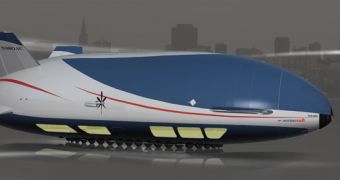Old technologies come with solutions for the future. The airship of the future looks like a dirigible and has 5,000 square ft (560 square m) of living and/or cargo space.
"The planned Aeroscraft ML866 is much more than an advertising blimp or one of those huge passenger dirigibles of the 1930s," said Edward Pevzner, business development manager at blimp-maker Worldwide Aeros Corp.
"It can be finished as a personal yacht, a business commuter craft or cargo carrier," he said.
Aeroscraft ML866 would be a low-maintenance, non-buoyant airship that could take off from any airport and would transport 2 to 20 people.
"It's designed to get rid of all the problems associated with conventional airships, such as the need for a ground crew, mooring equipment and susceptibility to weather," Pevzner told LiveScience.
70 % of its weight will be supported by helium as a lifting gas and the rest of the lift will be generated by engines through dynamic lift.
Aeroscraft has a fat, short surfboard design and could simply operate on any open field that will accommodate its length (210 ft or 70 m) and girth (95 ft or 32 m).
The largest hydrogen-filled blimp, Hindenburg, operating in the 1930s had 6,000 square ft (660 square m) of floor space on two decks and an 804-ft (210 m)-long and 135-feet (45 m)-wide hull and required a crew of 250 persons pulling ropes for landing. Hindenburg tragically demised during the landing in New Jersey in 1937.
The Aeroscraft will have to lift about 7 tons, compared to 112 tons for the Hindenburg (mainly fuel, ballast and a 40-person crew).
"Configured for freight, the Aeroscraft could deliver cargo to anyplace with enough open space to allow a landing," said Pevzner.
The Aeroscraft could reach a speed of 120 mph (200 kmph), opposed to 77 mph (120 kmph) for the Hindenburg. "With a cruising range of 3,100 miles (5,000 km), the Aeroscraft is not intended to cross the Atlantic," Pevzner noted. (while Hindenburg did it as a routine.)
The Aeroscraft can fly up to 12,000 feet (4,000 m), while Hindenburg usually moved at 750 feet (250 m) so the passengers could open the windows. The price of Aeroscraft would be "competitive with private jets." said Pevzner.
"Test flights are scheduled to begin in 2010. In the meantime, the company is negotiating with the Federal Aviation Administration concerning that kind of licensing the pilot and co-pilot of an Aeroscraft will need. The FAA offers different licenses for airplane pilots and blimp pilots, but the Aeroscraft will be neither," explained Pevzner.

 14 DAY TRIAL //
14 DAY TRIAL //